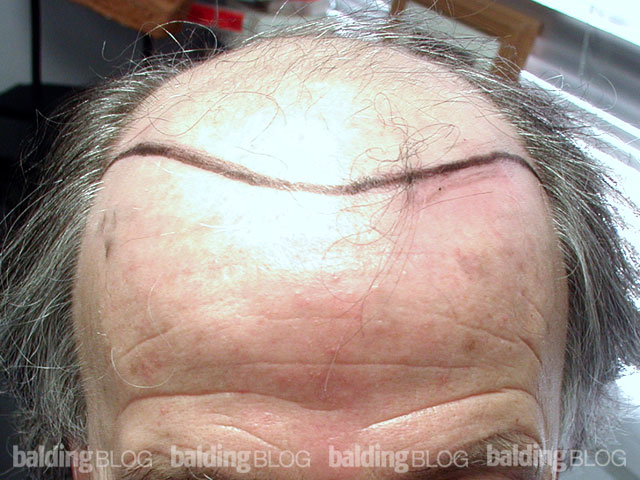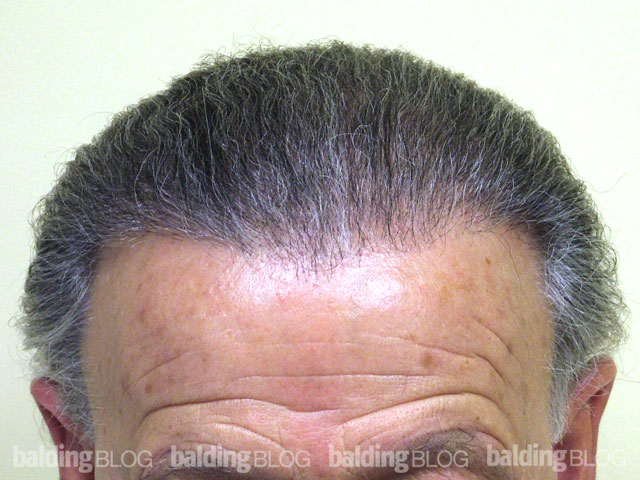A hair biopsy or rather a scalp biopsy takes a small piece of your scalp out with a knife or punch, and sends it off to pathology to view it under a high powered microscope after it has been prepared and stained. A HAIRCHECK instrument tests for the thickness of the hair in a defined area of the scalp. As this can be compared area by area, the differences always reflects loss of hair bulk or hair mass. The HAIRCHECK test is non-invasive while the biopsy is invasive
Difference Between Norwood Class 7 Patients (with Photos)
Why is there such a difference between these two previous post’s photographs. They are both, by your report, Class 7 patients.
 Thanks for asking this great, insightful question.
Thanks for asking this great, insightful question.
The rim of hair in a Class 7 balding pattern contains about 30,000-35,000 hairs. Considering that the normal total hair count of an adult is about 100,000 hairs, the only permanent hair that is never lost in any balding man, is the 3 inch high rim of hair schematically shown on the right (Norwood Class 7 pattern). The art of hair transplantation that I will show you below, reflects the way the surgeon redistributes these 30,000 (or less) hairs so that it looks like more than it is. The surgeon needs all of the help he/she can get from the characteristics of the hair on the patient’s head, including the quantity that can be safely moved.
The texture of the hair in these two patients is very different. The white/grey haired man (let’s call him ZU) has a hair shaft thickness that is easily three times the hair bulk (weight) as the blonde fellow (and for the sake of consistency, we’ll call him BF). The hair of ZU has a good character to it and holds a wave nicely, while BF has hair that lies limp and wimpy. Also, the donor supply of ZU is easily twice as good as BF and has a loose scalp which allows the surgeon to redistribute more hair from the permanent rim of hair around the sides and back. ZU received almost 10,000 grafts with easily 23,000 hairs in these grafts, while BF had only 4500 grafts (about 8,000 hairs). BF’s scalp was tight and his hair density was not as good as ZU. With that understanding, re-read the blog post titled Patient’s Guide — How Many Grafts Will I Need?, and it should be easy to see that we are not all created equal and the surgeon’s hands are ‘tied’ by patient’s hair characteristics (weight, texture, color, quantity) and therefore the hair transplant surgeon is not in control of every variable he/she needs. When putting the patient’s final results side-by-side, ZU has easily 8-9 times the amount of hair bulk (# of hairs and bulk) as BF. What is very important for you, the reader, to recognize here is that even BF is thrilled with his results. The thinly covered crown in BF (both men use a comb-back hair styling technique) is not of a concern for BF, because he looks at the man in the mirror and does not see his hair from behind. ZU also has a comb-back (which I showed in these photos by allowing the hair that is combed back to separate so you can see the scalp) with much better coverage of his crown area. ZU also had a considerable amount of hair transplanted into the crown, making his grooming easier and his crown looking fuller. From BF’s point of view, that man he sees in the mirror has a full head of groomable hair, just like ZU.
It is also important to note that these men started getting hair transplants at different points of their hair loss. ZU was already completely bald when he started getting transplants, where BF was thinning rapidly and on his way to being completely bald (it happened a few years before Propecia became available). So ZU had nothing on his scalp when we began transplanting his head, and BF eventually lost all of his natural hair up top (so what you see in the photos for both men is all transplanted hairs). If you took BF’s hair transplants away, he would look like ZU’s before photo.
This is reality and that is why I appreciated this question when it came in yesterday. People with a Class 7 balding pattern will never have enough hair to replace what was lost (and if any doctor said he/she can give such a person a full head of hair, well, he/she clearly is must be GOD). The key to a good hair transplant is the artistic hand of the surgeon and good styling from the patient, no matter what balding pattern exists.
ZU (before on left, after in middle, after crown on right — more photos here):


BF (before on left, after in middle, after crown on right):
2007-05-25 15:36:572008-05-06 13:45:01Difference Between Norwood Class 7 Patients (with Photos)
Diffuse Patterned Alopecia
Hi Dr Rassman!
I’ve been said I have male pattern baldness by a doctor. I’m currently 21 years old I lose my hair since I was 14. From reading articles over the internet, I think I have DPA (Diffuse Patterned Alopecia). My hair is thinning on the top, but remains thick on the sides. I have loss at the temples and crown in a diffuse way, but not restricted to these places (also thinning all the top). I currently take Propecia since I was 18. I don’t know if it’s helping, but I take in case it would be worse without it.
I’d like to know what causes DPA. Is it really androgenetic? Can it be from poor diet and life style? Is it reversible? What are the best options for treatments? Thank you for your attention and this excellent website!
Diffuse patterned alopecia (DPA) in men is mostly genetic in origin and Propecia (finasteride 1mg) is a good way to treat it. Have you had your hair mapped out for miniaturization to be sure? What is the result of your hair pull test? This test may point to a diffuse telogen effluvium. I can not really diagnose you via this site without examining you first.
Diffuse Alopecia Areata vs Telogen Effluvium
Hi doc,
How do you tell the difference between Telogen Effluvium and Diffuse Alopecia Areata?
Diffuse alopecia areata can look very similar to telogen effluvium. The only way to tell these two diagnosis apart is by performing a series of biopsies of the scalp. Alopecia areata can be diagnosed histologically.
2009-02-18 09:32:012009-02-12 15:13:49Diffuse Alopecia Areata vs Telogen Effluvium
Diffuse thinning
Do fin or min+fin work well for diffused thinners? Also please give advice on regimens that have worked for you if you’re a diffused thinner. I am 18 years old.
Diffuse thinning has many causes. You need a good examination by a hair doctor that understands hair loss and hair thinning. If it is part of the genetic hair loss that you inherited, then finasteride and minoxidil are the staples of treatment.
Diffuse Hairloss and Sebum Plugs
I’ve have consistent diffuse hairloss universally around my head for about a year and a half, to the point where I believe I’ve lost about 60-70% of my hair. Many of the hairs that fall have large white plugs attached to them (see pictures), which I believe may be sebum.
Is this in fact sebum? Can these plugs cause diffuse hairloss? Any idea what may cause them or what might treat them? So far, I’ve tried zinc, ketoconazole, salicylic acid, coal tar, and other “sebum reducing” shampoos. I have also been on propecia for 6 months, but with no noticeable reduction in the pace of my loss.
Sebum is a waxy substance from the production of oil from your sebaceous glands. It can be seen on ends of hair follicles that fall out but this does not mean you have a hair loss condition or disease process (because of the sebum). There are products that claim better control of sebum and Internet posts that claim the sebum is the cause of hair loss. It generally makes for great marketing campaign to sell a product to those who are looking for a hair loss cure. Sebum does not cause hair loss, if it did, the many men and women on skid-row would be balding as they often do not shampoo their hair and reduce their sebum buildup. If you are experiencing diffuse hair loss, I doubt sebum is the root cause (no pun intended). You need to see a doctor for your hair loss condition to establish a good diagnosis.
Should Diffuse Thinning Be Treated with Hair Transplantation? (from Reddit)
2018-09-09 10:53:392018-09-14 09:06:55Should Diffuse Thinning Be Treated with Hair Transplantation? (from Reddit)
Diffuse thinning and not getting better
hi doctor, i’d like to apologize’ first because i dont have good progress pics to post but i’d still like to get some advice
i’m a diffuse thinner and i’ve been using minox for 9 months and finasteride for about 7 month. was losing 100+ strands of hair daily when i shower but since last month the hair loss has gone down to around 50+ strands, should be a good thing right? but the problem is that my hair density and volume are way below baseline and it worries me a lot
what should i do, are there any other options? keep it up and just wait and see how it goes? i’m worried that my hair loss didn’t actually “improve” and i’m losing fewer hairs simply because i dont have as much hair to lose now compared to before, if you get what i mean.
There are thickening agents you can buy which will make your hair look much better. These medications will hold the hair you have and not regrow new hair. You need to see a doctor and get a Personalized Master Plan for your hair both short term and long term, knowing where you are going will be helpful for your future planning.
2020-12-15 02:02:222020-12-15 07:07:33Diffuse thinning and not getting better
Diffuse Unpatterned Alopecia-DUPA
I have a Class 3 balding pattern (just corner loss) and I went to a hair transplant doctor who offered to perform 2000 grafts in the front to address the balding area. It seemed to me that I was thinning outside of my frontal balding area. The doctor who offered me the surgery never looked at my hair under a microscope. I am a 24 year old male and I purchased a hand microscope as you suggested on Amazon. When I looked at my donor area, this is what I saw in different parts of the donor area. How would you interpret the hand microscope pictures I have attached here?
This is clearly Diffuse Unpatterned Alpopecia (DUPA) which I originally wrote about in 1997 (see here: https://baldingblog.com/wp-content/uploads/pdf/mp-1997-evaluation.pdf). The view of your donor area shows very significant miniaturization of the donor area which means you are not a candidate for a hair transplant because it will fail. The hairs that get transplanted will look like these hairs and not have much bulk to them. The doctor who recommended 2000 grafts just wanted your money and probably never read about DUPA. You seem too smart for that doctor. The drug finasteride sometimes helps.
Diffuse Hair Loss
(female) Dear Drs,
I was told that I most likely am suffering from Diffuse Areata, the thing that directed my doctor to this diagnosis is diffuse all over hair loss, brow and lash shed and short tapered hairs shedding out. I can find nothing on the subject, nothing on the net and my doctor admitted he did not understand the disorder.
Could you provide me with information regarding the diffuse form leaving no bald spots but diffuse loss all over the head. What is the general prognosis etc?
Thanks for your help
First, I want to tell you that clinical medical science is a descriptive science in many situation. This is important because what we see is what we are reporting when we diagnose diffuse alopecia areata. What doctors are saying is that there is a diffuse form of the disease that mimics classic alopecia areata, except that it is found all over the head. Some doctors question if this is the same disease, but because it looks like the same entity when the skin is biopsied as localized alopecia areata, the conclusion is that the diffuse variant is different in ways that are not understood. Most people believe that it is an autoimmune disease and we see evidence in what we call chronic and diffuse alopecia areata of the microscopic changes seen in autoimmune diseases.
Second, I can point you to some sites of interest so that you can learn more (but hopefully not confuse you):
- National Alopecia Areata Foundation
- Journal of Investigative Dermatology – Role of Cytotoxic T Cells in Chronic Alopecia Areata
- American Journal of Dermatopathology – Diffuse Alopecia With Stem Cell Folliculitis: Chronic Diffuse Alopecia Areata or a Distinct Entity?
- American Journal of Clinical Dermatology – Alopecia Areata: Pathogenesis, Diagnosis, and Therapy
2008-04-10 15:32:382008-04-04 14:25:02Diffuse Hair Loss


